Lectric XPedition 2.0 Review | Can Budget Beat the Rest?
Lectric’s new-and-improved cargo bike has better looks, more features, and the same great performance for a ridiculously low price.

Cargo e-bikes offer a healthy, active method of running errands and spending more time with the family, but their cost can be prohibitive. In an era when the cost of everything is high and seemingly always rising, purchasing an e-bike—plus all the accessories needed to haul kids and cargo—may simply not be an option for many families.
Lectric, a brand known for its affordable and highly portable folding e-bikes, set out to make owning an electric cargo bike attainable for the average family with the first-generation XPedition a couple of years ago. The bike had a high weight capacity and a low price that made it appealing, but it was otherwise relatively spartan.
Now, the redesigned XPedition 2.0 boasts an even more reinforced frame, a more refined aesthetic, new programming, and a boatload of additional features—all starting at the same entry-level price below $1,500.
The base model is well-equipped with a capable 750W rear hub motor, an 8-speed drivetrain, hydraulic disc brakes, and integrated lights and turn signals. It also includes a 624-watt-hour (Wh) battery with an estimated range of 60 miles and basic passenger accessories such as seat pads and footboards.
Lectric also offers two upgrade levels: a mid-tier option with two 624-Wh batteries and a high-end long-range model with two 840-Wh batteries. These options include even more accessories and are advertised to achieve up to 120 and 170 miles of range, respectively—and all three options share a total payload capacity of 450 lbs!
Range is just one aspect of the XPedition 2.0’s performance we tested while reviewing the bike. See below to see how this cranked-up cargo hauler compares to the competition!
Class 2 (throttle to 20 mph)
Class 3 (pedal assist to 28 mph)
 Pros
Pros- This bike’s value is incredible! Starting at around $1400, it’s one of the most affordable cargo e-bikes we’ve tested, and it includes many features and accessories shared with more expensive models.
- The XPedition 2.0 has a staggering payload capacity of 450 lbs. It can carry up to a 330-lb rider, and its cargo rack can support up to 300 lbs.
- It has an easy ride with plenty of power to move a heavy load. A 750W motor paired with Lectric’s PWR+ programming delivers ample power even with relaxed pedaling.
- Buyers can select between three battery capacity options to suit their needs and budget, with a maximum advertised range of 170 miles!
- The bike fits an impressive range of riders from 4’11” to 6’5” thanks to its extended seatpost and quick-adjust stem.
- It comes with starter accessories such as seat pads and footboards for carrying passengers. More accessories are included with the higher price tiers.
- The bike rides smoothly thanks to its custom suspension fork with 50mm of travel and suspension seatpost with 40mm of travel.
- It has a variety of safety features, such as brake lights, turn signals, a variety of throttle power levels, and UL2849/UL2271 Certification.
 Cons
Cons- We liked that the hinged kickstand stayed out of the way when riding and kept the bike stable when loading, but setting it up was more difficult than we’d prefer.
- Battery: Removable 48V, 624 Wh (Base Model), 2x 48V, 624 Wh (Dual Battery), 2x 48V, 840 Wh (Long-Range Dual Battery)
- Display: Backlit color LCD w/USB-C port, IP65-Rated
- Motor: 750W (1310W Peak), 85 Nm Torque
- Headlight: Integrated LED
- Taillights:Integrated LED
- Pedal Assist: PAS 1-5, PWR+
- Claimed Range: Up to 60 Miles (Base Model), Up to 120 Miles (Dual Battery), Up to 170 Miles (Long-Range Dual Battery)
- Throttle:Left Hand Thumb Throttle
- App:N/A
- UL Certification:UL 2271 & UL 2849 Certified
- Claimed weight: 65 lbs. (without 9-lb battery)
- Tested Weight: 75 lbs. (without 9-lb battery)
- Rider height range: 4’11” to 6’5”
- Total payload capacity: 450 lbs (Up to 330 lbs Rider, up to 300 lbs Rack)
- Brakes:Hydraulic Disc Brakes, 180mm Rotors
- Fenders:Plastic w/ Integrated Rear Wheel Guard
- Fork:Custom Courier 50 Dual-Spring Suspension Fork w/ 50mm Travel
- Frame: Hydroformed 6000-Series Aluminum
- Drivetrain:8-Speed Shimano Altus, 52T Chainring, 11-32T Cassette
- Grips: Lock-on Ergonomic Rubber
- Saddle: Custom
- Handlebar:
- Kickstand: Dual Leg, Center-Mounted
- Pedals: Quick-Release Aluminum
- Tires: 20×2.5” Puncture-Resistant Street Tires
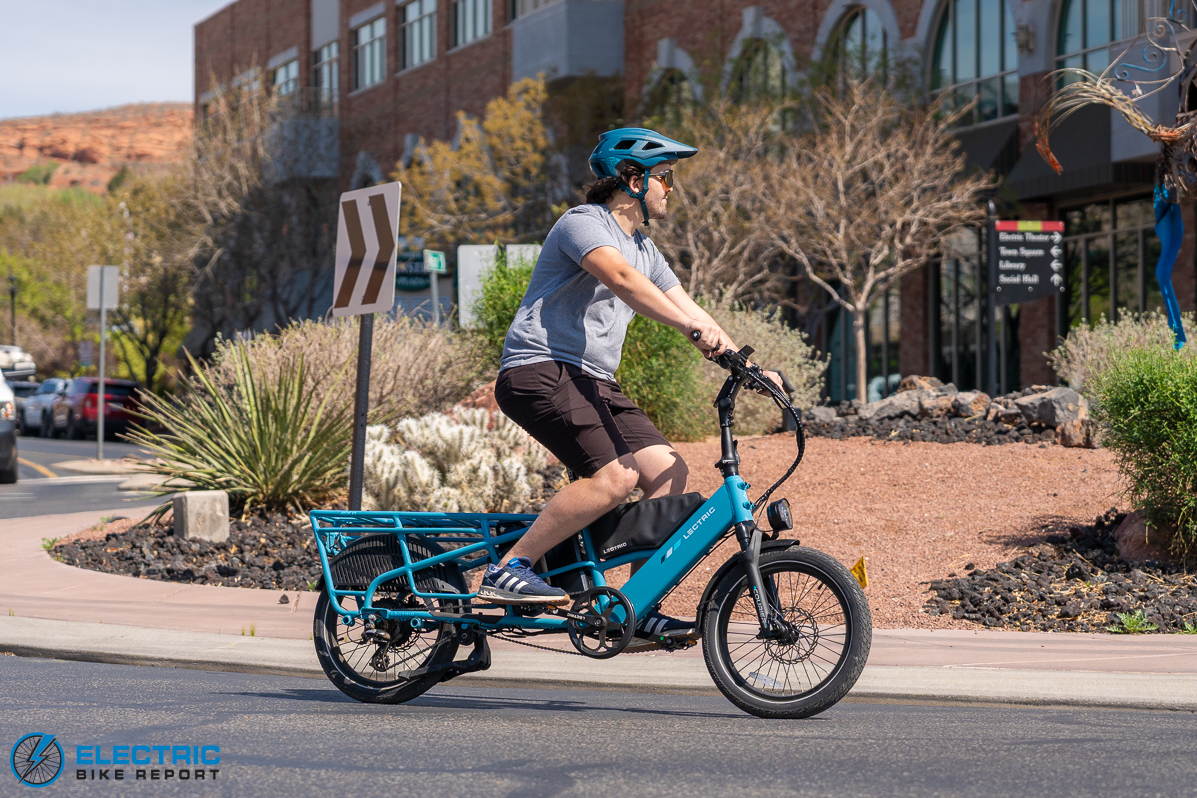
As a Class 2 e-bike, the XPedition has a 20 mph speed limit out of the box, but it can also be set to a faster Class 3 mode.
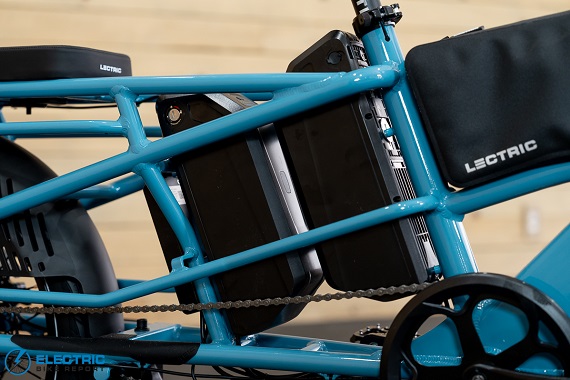
We tested the Long-Range Dual Battery version that came with two 840-Wh batteries.
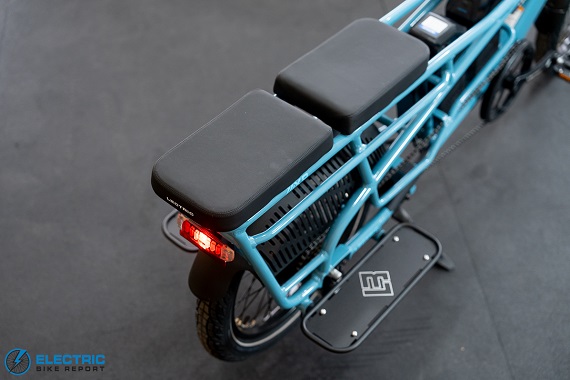
Even the base model comes with passenger-friendly accessories, including seat pads and footboards!
Lectric XPedition 2.0 Review: Speed Test
The XPedition 2.0 has a 20 mph speed limit shared between its throttle and pedal assist system, making it a Class 2 e-bike. It can also be set to a Class 3 mode with pedal assist up to 28 mph through its display.
We tested it in both modes in our Speed Test to A) ensure it could reach its advertised maximum speeds, B) understand how its power is distributed across its five pedal assist settings, and C) get a feel for the forcefulness of its acceleration when using the throttle. I performed this test on a flat section of a paved shared-use path; my data is graphed above.
To address our first goal, it’s clear that the bike had no trouble reaching the Class 2 and Class 3 limits of 20 and 28 mph, respectively.
Regarding our second goal of observing power distribution, there were mixed results, at least on paper.
In the Class 2 test, the power level of PAS 3 was enough to get the bike close to its speed when riding on flat ground and without cargo. As such, my results in PAS 3, 4, and 5 were all very similar, so its power distribution does not appear balanced. Outside of the test, however, I noticed that there were more obvious differences in power when riding uphill or with weight on the cargo rack.
The Class 3 graph shows a much more balanced distribution of power between the five assist levels with relatively intuitive, incremental jumps in speed between settings.
When testing the throttle to address our third goal, I noticed that the bike’s acceleration changed depending on the pedal assist level. It picked up speed gradually but steadily in its low-power settings, but it could be a bit punchy in higher assist levels.
As such, we recommend the lower levels to guarantee balance and control when carrying child passengers. The mid- and high-power assist levels have plenty of power for moving a heavy load.
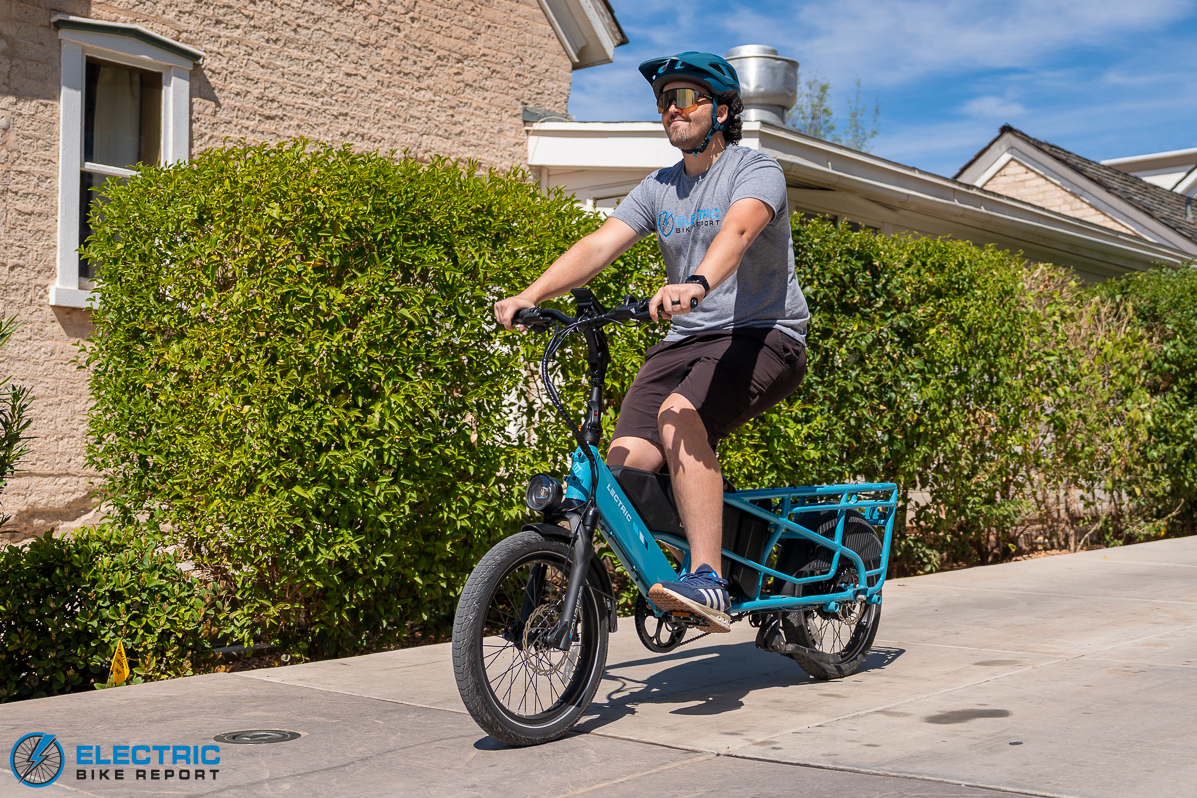
The XPedition fits riders from 4’11” to 6’5” and can carry up to a 330-lb rider.
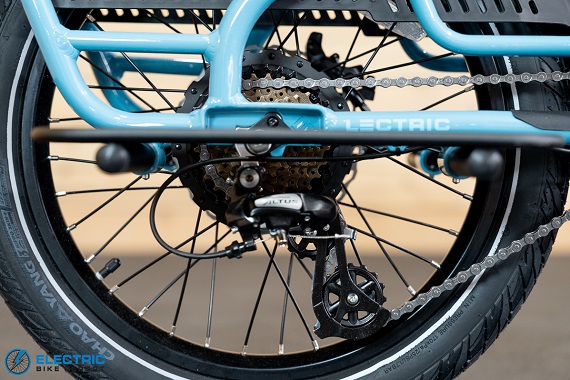
An 8-speed drivetrain provides gearing for both flats and hills. It was effective for both Class 2 and Class 3 speeds.

The studded aluminum pedals are light and sturdy. They also feature a quick-release mechanism to make the bike more compact.
Lectric XPedition 2.0 Review: Range Test
We used the general process explained in the graphic above to determine how many miles the XPedition 2.0 can travel on a single charge. Our methodology and results are more complex than usual because of the bike’s three spec tiers, so I’ll explain the details before analyzing the results below.
We tested the Long-Range dual-battery version of the bike with two 840 Wh batteries and an estimated range of 170 miles. Due to the extreme time requirements of riding a bike for such a substantial number of miles, we tested the bike with a single battery with the assumption that doubling our result would be within the margin of error.
As one might expect, we used the highest power level in PAS 5 to get the bike’s minimum range, but we chose PAS 2 for our maximum range test. We opted for this setting instead of the lowest power level because the motor output in PAS 1 is likely below what most riders would prefer, especially when carrying cargo or passengers.
With one 840-watt-hour battery, our test rider traveled 37.2 miles in PAS 5 and 67.6 miles in PAS 2. We tested the bike in Class 2 mode without cargo, so we would expect fewer miles when riding faster with Class 3 settings or when carrying additional weight.
I used our numbers to calculate range estimates for all three versions of the XPedition 2.0 based on the number of watts used per mile (12.4 in PAS 2 and 22.6 in PAS 5), as shown below:
- Base Model (one 624-Wh battery): 27.6 to 50.2 miles
- Dual Battery Model (two 624-Wh batteries): 55.3 to 100.4 miles
- Long-Range Dual Battery Model (two 840-Wh batteries): 74.4 to 135.2 miles
In all cases, our calculated estimates fall somewhat below Lectric’s advertised range for the three versions of the bike, but the bike showed better-than-expected efficiency. Based on our Speed Test results, the 750W motor and the single 840-Wh battery used in our testing, we expected our test rider would cover roughly 18 miles over roughly an hour and 7 minutes. Our real-world test showed roughly two times the mileage and ride time!
Due to the complexity of our testing process, our results with a single battery, and the calculations for the XPedition 2.0’s three spec levels, comparison with similar models is difficult.
Our range estimates for the single-battery base model place the bike behind the cargo category averages of 33.3 and 63.7 miles (at the time of writing). These results make sense when considering that its 624 Wh battery is also smaller than average for the category; cargo bikes average 727 Wh.
Our test results with one 840 Wh battery were slightly above the category average, however, so we encourage Lectric to offer a single long-range battery version in the future. With that in mind, the XPedition 2.0 performed well in this test, and its current three options still give buyers plenty of choice over how much range the bike can offer and how much it costs.
Lectric XPedition 2.0 Review: Hill Test
At the time of writing, the average throttle time for cargo e-bikes in our Hill Test is 1:20, making the XPedition 2.0 six seconds faster. Cargo bikes average 1:10 using their highest level of pedal assist, so the XPedition was 3 seconds faster in its PAS 5 test.
A slight difference in results makes sense when considering motor output; Lectric’s motor peaks at 1310W and produces 85 Newton meters (Nm) of torque. Its peak is roughly 150 watts higher than average, while its torque is right around average.
Once again, we performed this test without additional cargo weight, but I did a separate informal test to evaluate the bike’s climbing ability when carrying a payload. I loaded 60 lbs into a set of pannier bags attached to the cargo rack and pedaled to our secondary Hill Test location, called Pilot Hill.
There, I recorded throttle and pedal assist times of 1:06 and 1:05, respectively, without the panniers. My speed dropped 2-3 miles per hour when I added them to the cargo rack, resulting in roughly 10-15 seconds of difference; my times in the second test were 1:20 and 1:12. The added weight clearly slowed the bike down, but it always felt strong and steady.
This test is where I noticed the biggest advantage of Lectric’s PWR+ programming (more on that in the Ride Quality section below). The addition of 60 lbs weighed the bike down, but it didn’t greatly affect how easy it was to pedal.
I found that the baseline of the motor’s power output was high, regardless of how much effort I applied, but it gave me more power when I pedaled harder. This programming made the XPedition one of the easiest cargo bikes with a torque sensor I’ve tested to date when it comes to pedaling uphill.
As shown by our formal test results and my personal experience in an informal test, the XPedition 2.0 is a highly capable climber. It pedals uphill easily and effectively, and of course, riders also have the option of hitting the throttle and taking it easy.
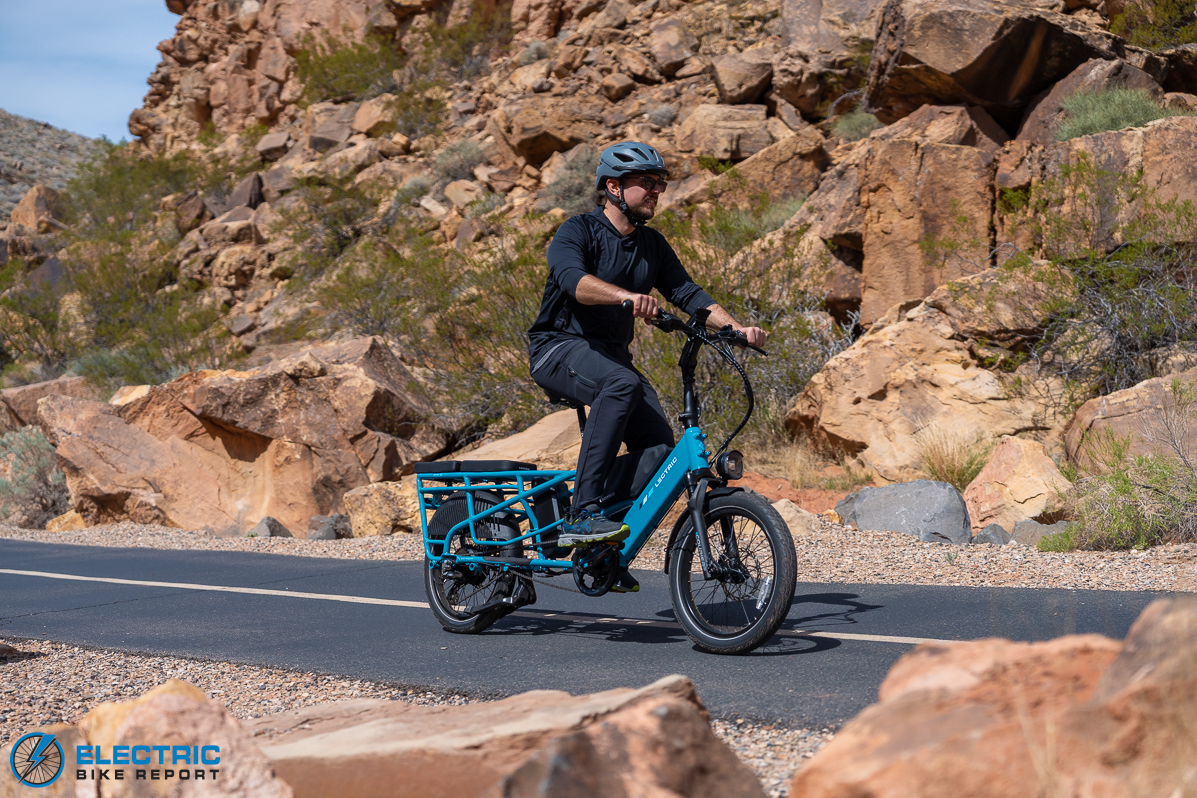
The XPedition 2.0 is available in two color options, including Raindrop Blue (pictured) and Stratus White.
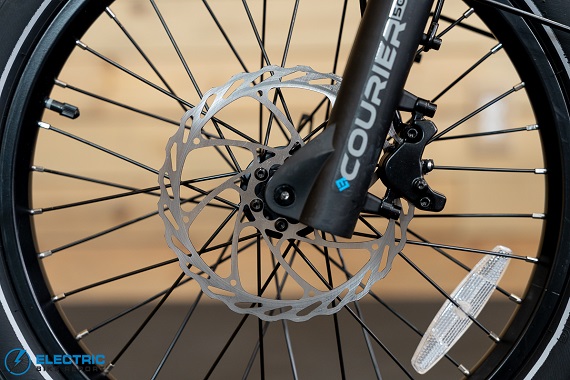
The XPedition 2.0 features a hydraulic disc brake system with 180mm rotors on both wheels.
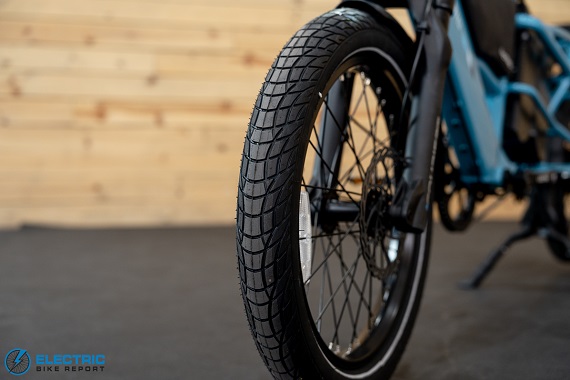
20×2.5” Chaoyang street tires keep the bike’s center of gravity low while providing stability and cushion.
Lectric XPedition 2.0 Review: Brake Test

The XPedition 2.0 is equipped with an unbranded hydraulic disc brake system that pairs 2-piston calipers with 180mm front and rear rotors. We tested its braking performance using the method explained above; its result was 21’6” for an average stopping distance.
The bike stopped effectively in the zone we consider safe and effective, remaining stable and not deviating from its line of travel. When compared with similar models we’ve tested, however, its result was somewhat slower than average. At the time of writing, the cargo e-bike category averages 19’8” in this test.
To determine why the XPedition was slower in this test than many of its peers, I considered a few things, including its brake system, its weight, and its tires.
The bike’s brake system is relatively standard when compared with the other cargo bikes used for comparison. Its brake components may be unbranded, but judging by the shape of the brake levers, the system is likely made by Tektro. Considering the performance and ubiquitous nature of Tektro brakes on the vast majority of e-bikes we review, we are confident the bike is specced appropriately.
Without batteries, the XPedition 2.0 weighs roughly 75 lbs, with each battery adding approximately 9 lbs. The bike was equipped with a single battery during our Brake Test, giving it a total weight of roughly 84 lbs. This weight is relatively average for the cargo category, as the cargo bikes we have reviewed averaged 88 lbs, meaning that weight likely did not impact this test significantly.
When testing the bike both with and without 60 lbs of additional cargo weight, I noticed that the brakes felt better when the bike was loaded up. Without weight, braking felt controlled, but the XPedition’s tires squealed loudly, and it was prone to skidding. Once weighted down, its tires seemed to have better grip on the road, so it stayed more firmly stuck to the ground.
The XPedition’s test results are good overall, but riders planning to use the bike regularly without cargo who want to shorten their stopping distance may consider switching to a gummier tire. In general, the bike did a solid job in this test, so we do not consider any changes to its brake system necessary.
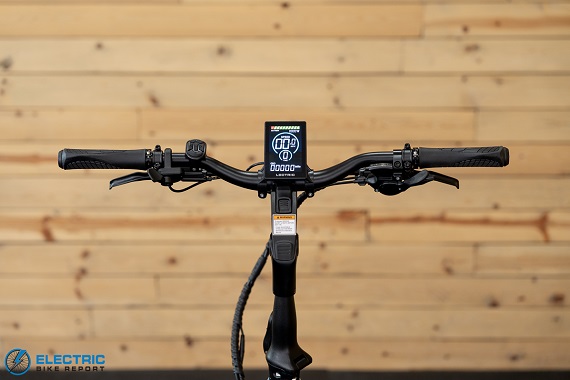
The 670-mm handlebars provide a good balance between compact design and precise steering control.
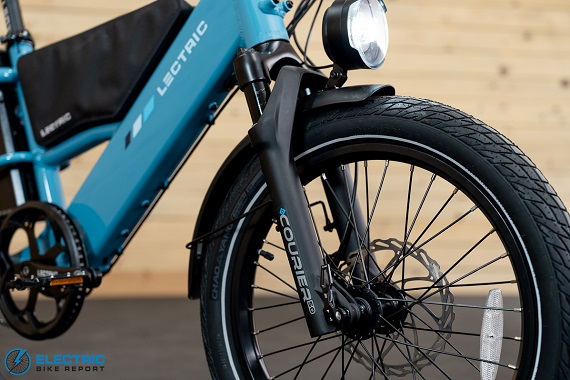
The bike is equipped with a custom suspension fork with 50mm of travel.
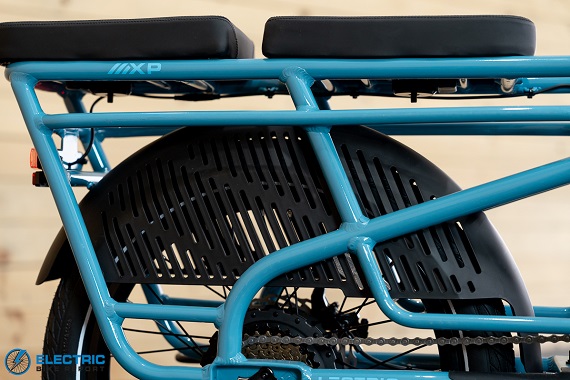
The rear fender includes a molded-in wheel guard to protect child passengers.
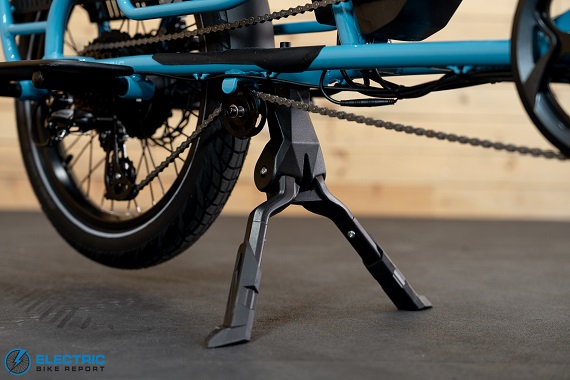
A hinged, spreading kickstand folds to prevent getting caught while riding, but it wasn’t the easiest to use.
Lectric XPedition 2.0 Review: Ride Quality
The bike’s single frame size comes with a recommended height range of 4’11” to 6’5”. It is difficult for a single size to accommodate such a broad swath of riders, but the XPedition accomplishes this with an extended seatpost and a quick-adjust stem, allowing users to alter its fit and riding position. According to our measurements, the bike offers roughly 11” of adjustment in saddle height and 3.5” in handlebar height.
At 5’11”, I fall within the top third of the recommended height range. The long seatpost ensured that I had full leg extension, while the adjustable stem allowed me to set a comfortable handlebar height. I experienced a slight forward lean with a relatively long reach, though I could have raised the stem further for more upright positioning.
The bike’s geometry felt comfortable, as did its custom saddle and ergonomic rubber grips. The combination of a suspension fork and a suspension seatpost effectively smoothed out bumps and dips without feeling too divey when carrying cargo.
Cargo e-bikes have a handful of ride quality considerations that other styles of bike do not: they must remain sturdy, stable, and controlled under load. I’m happy to say the XPedition 2.0 carries cargo with poise! Its frame is among the sturdiest we’ve tested, with little noticeable frame flex. Its 20×2.5” tires keep its center of gravity low for great balance while providing a wide base for stability.
Overall, the bike handled well. Its small wheels helped to counteract its long wheelbase by increasing maneuverability. As with all cargo bikes, it felt inevitably less agile when loaded with cargo, but slower speeds and more gentle cornering are recommended for safety when carrying additional weight.
One area with room for improvement is the bike’s hinged kickstand, which I found relatively difficult to put in place. I appreciated that its profile narrows when folded to stay out of the way, but propping the bike up required wrestling it up and back over the kickstand’s legs, which became more difficult with added weight. We encourage Lectric to find a more user-friendly kickstand in the future.
As with a few of Lectric’s other e-bikes, the XPedition 2.0 features a torque sensor paired with the brand’s custom PWR+ programming, which aims to incorporate the benefits of a cadence sensor. The result is a remarkably easy pedaling experience that is well-suited to getting the bike moving when carrying cargo or passengers.
Essentially, the motor provides power up to a certain amperage (varying by pedal assist level) regardless of whether the rider applies significant pressure to the pedals. Thanks to its torque sensor, however, the motor is able to deliver more power as the rider pedals harder.
In general, this custom programming is successful, but if I’m nitpicky, the balance between steady and responsive power delivery (cadence vs torque sensing) seemed slightly off. I personally would prefer more responsiveness, but I also recognize that I have the privilege of comparing the feel of hundreds of e-bikes; most riders will likely not mind.
I found the XPedition 2.0 easy to operate thanks to its relatively simple cockpit layout. The rubberized control panel, which includes buttons for the integrated turn signals, felt like a step up from the basic two-button pad on most of the brand’s other models. In fact, I have to give Lectric kudos for including indicator lights, as few bikes in this price range offer them.
I was also happy with the inclusion of a suspension seatpost and a throttle with a variety of power levels. Truly, the XPedition 2.0 offers an incredible amount of value with all of its features and accessories! With a comfortable ride, the power to carry a high payload, and a straightforward user interface, the bike’s ride quality is great overall.
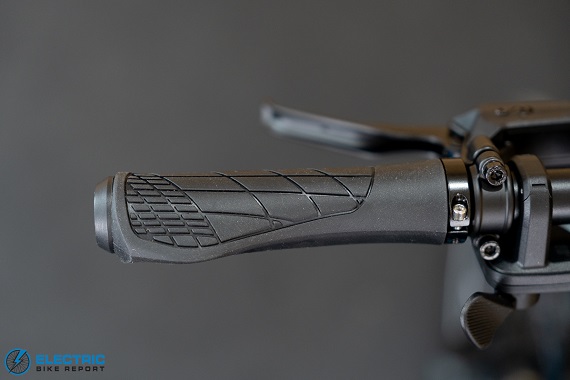
We liked the bike’s comfortable, ergonomic rubber grips.
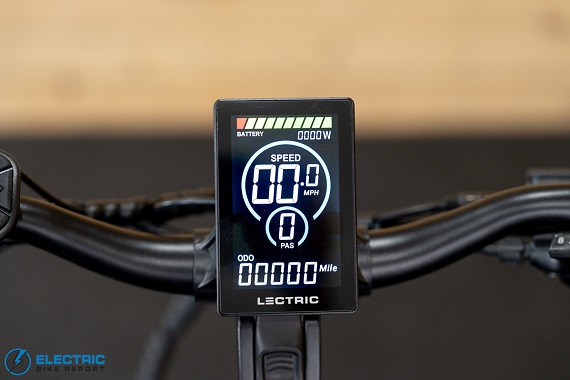
The color LCD is simple and effective, with all relevant ride data and arrows for the integrated turn signals.
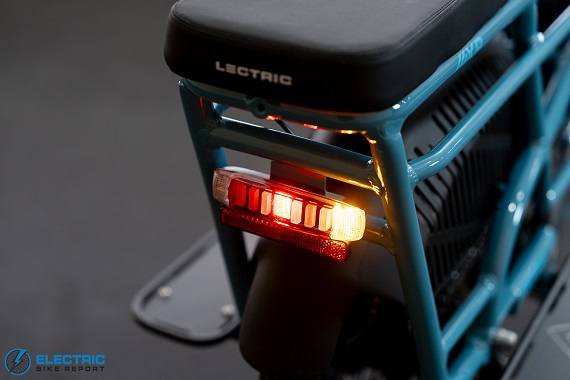
The tail light, mounted below the rear cargo rack, offers brake light functionality and also includes integrated turn signals.
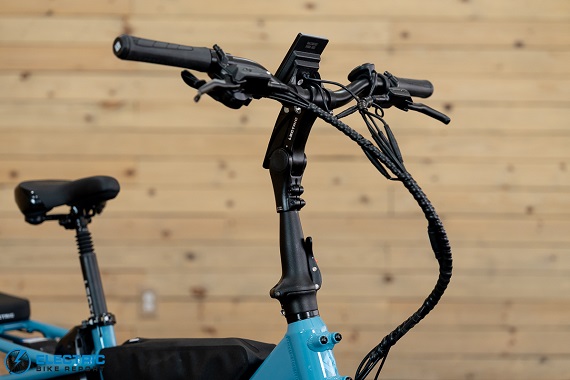
An adjustable stem mounted to a collapsible stem allows the bike to adapt its fit and become compact when needed.
Lectric XPedition 2.0 Review: Summary / Where to Buy
As our testing showed, the bike is an excellent performer. It has good brakes, an efficient motor with a variety of competitive range options depending on its spec level and battery size, and impressive climbing power with both its throttle and pedal assist system. Its programming and power delivery are off to a good start, even if there’s a bit of room for improvement.
We hope to see a slightly easier-to-use kickstand in the future, but considering that this is our largest point of critique (as opposed to a performance-related concern), it’s clear that Lectric was overwhelmingly successful with the XPedition 2.0. Its upgrades took the brand’s first attempt at a cargo e-bike from good to great—they knocked this one out of the park!
We highly recommend the XPedition 2.0 for families and delivery workers seeking a fully functional, feature-packed cargo e-bike on a budget. Its ability to carry up to 300 lbs on its cargo rack makes it a great choice for those wanting to carry an adult passenger, a load of groceries, a stack of pizzas, or a couple of children.
With three available spec levels, shoppers can choose an option that saves on cash or one that arrives set up for hauling kids or cargo all day—or possibly all week—long.
Considering that the Long-Range Dual Battery version, which includes all sorts of cargo/passenger accessories and a ridiculous battery capacity, can be purchased for less than the cost of many similar bikes on the market, the XPedition 2.0 is one of the smartest e-bike purchases we can recommend!
Happy Riding! Make sure to let us know if you have any questions or if you think we left anything out in this review of the Lectric XPedition 2.0 down in our comments section.




Thanks for calling out the comparison of this bike vs. the Radwagon 5 and Flyer Via Pro. I’m looking forward to your insights on the value proposition between the bikes, especially considering the substantial price difference.
With this upgraded model, Lectric fixed everything that bothered me about the original Xpedition. There no longer seem to be any downsides to the bike, except that the narrower 2.5″ tires will make it less useful if you are planning to take it off-road. I also noticed that the Captain’s Chair isn’t available for the Xpedition 2.0, but I assume that will be coming in the future.
I have to wonder how the other long-tail bike makers are going to be able to compete with the Xpedition 2.0 — it offers so much more for a better price than any other budget long-tail cargo bike on the market. I have to wonder what Aventon, Velotric, Rad Power, Flyer, etc. can do to compete with Lectric. Even at the high-end, I have to wonder why bother paying over $5k for a long tail from Tern, Xtracycle, Yuba, Remmi, etc. when you can get the same functionality for a third of the price from Lectric. I guess that if you need some of the specialized accessories that Tern offers for the GSD, there is still a reason to buy the GSD, but I have to think that many buyers are going to decide that it isn’t worth paying that much extra for a mid-drive motor.